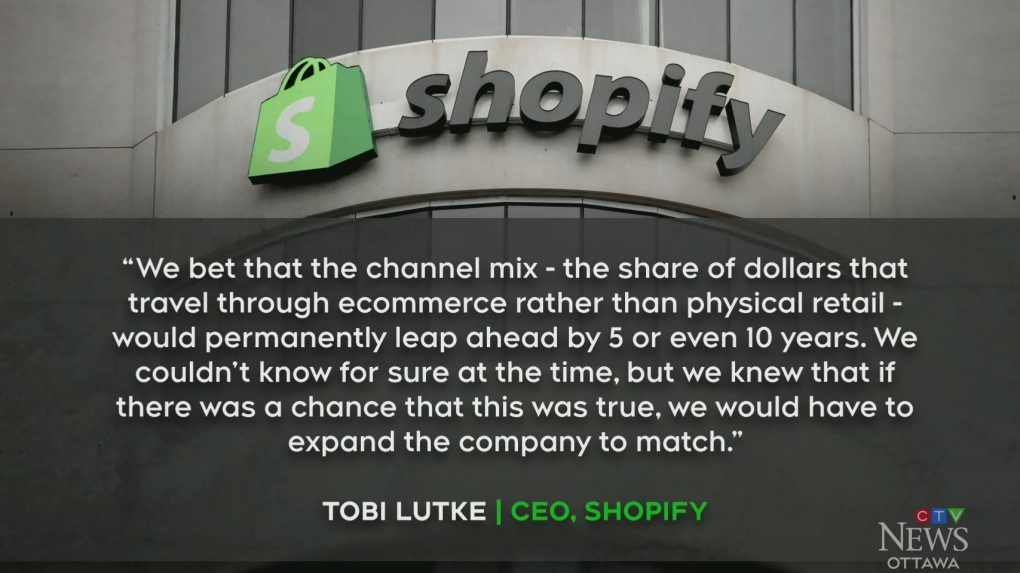From COVID care to cancer, there's a pattern to Danielle Smith's 'alternative' medical thoughts
UCP leadership candidate's health views aren't
mainstream.
But she doesn't need mainstream Alberta to
win
It's not a candidate's ideal day on the campaign trail when one must issue a video that takes pains to assert that, no, you did not intend to besmirch cancer patients and survivors in your video from a few days ago.
Danielle Smith, who seems to lead the race to become United Conservative Party leader and then Alberta's premier in October, got into the factually-dubious murk in a lengthy campaign video discussion with a naturopath about cancer being preventable and "completely within your control" until the disease reaches Stage 4.
Outrage ensued from the NDP ("cruel and wrong," said Rachel Notley) and UCP leadership rivals ("irresponsible" — Travis Toews, "hurtful" — Brian Jean), as well as medical practitioners and those who've survived cancer or lost loved ones to it.
When Smith tried to clarify her comments, she didn't walk them back; rather, she reiterated that the "first three stages of cancer are more controllable in terms of what complete care is available to a patient," and insisted that mainstream medicine and naturopathy alike agreed with this point.
We can dissect these comments shortly, but know what's clearly more preventable? Getting into this sticky situation by injecting alternative or contrarian medical arguments into a political discussion.
But this is par for the course with Smith, going back a few years.
She said what? — a retrospective
Her Twitter feed was completely within her control in the early days of the COVID pandemic, when she used a single study and something she'd read on some blog to proclaim that "hydroxychloroquine cures 100 per cent of coronavirus patients within six days of treatment." That would later be proven quite wrong. The bosses of her AM talk radio show took action, and Smith apologized and deleted that tweet.
Smith later gained more control of her own messaging by leaving Global News' radio show. On an online podcast, she'd also give lengthy airing to doctors she reported she wasn't allowed to host on her mainstream program — men who doubted much of the science of COVID, including one who called it "the greatest hoax ever perpetrated." She'd also advocate for wider use of ivermectin as coronavirus treatment, though it remained unapproved and would later be discredited and debunked.
Her own apparent curiosity on the fringes of established medical science brought her here, well before Smith was in a leadership race and cultivating a base of the same sort of pandemic-rule skeptics and detractors who rose up against Premier Jason Kenney's leadership of the UCP.
She now speaks often of the "vaccine choice movement," which would include anti-vaxxers and those forced reluctantly to get vaccines due to mandates. At a Calgary rally, she invited as her special guest Theo Fleury, the conspiracy-minded former hockey player who told her crowd the trauma from his sexual abuse was akin to the trauma of government pandemic rules.
Smith's supporters cheered for Fleury's message, and for hers.
These positions stray from the mainstream of Alberta opinion — and expertise — as does her "sovereignty act" proposal to stop enforcing in this province any federal laws a Premier Smith-led government deems run afoul of Alberta's jurisdiction.
But Smith doesn't need most Albertans to buy into her agenda. She just needs a select number, in the tens of thousands, to be UCP members by Aug. 12 and vote for her.
The whole reason she wound up gabbing for a full hour on video with a naturopath (including that bit about cancer being "controllable") was in support of her campaign promise to give every Albertan a $300 health spending account.
Like the supplementary health benefit packages that some employers offer, residents could spend it on areas the publicly-funded system doesn't cover, like vision care, dental care, massage therapy — and (in some plans) naturopathy, a field that many conventional medicine experts say suffers from lack of evidence and pseudoscience, although it is a regulated profession in Alberta.
The former radio host's podcast-style interview of Calgary naturopath Christine Perkins is largely promotional and complimentary of her field. Smith even at one point muses that the Alberta government needs, alongside a chief medical officer of health like Dr. Deena Hinshaw, a chief of integrative medicine and a chief of functional medicine — two "alternative" fields to traditional medicine.
Naturopathy has served to offer questionable alternatives for people who doubt mainstream health care and COVID science. Perkins tells Smith her naturopathic regulatory college won't allow her to discuss COVID matters, which the politician says "concerns" her.
Sometimes, backlash follows political comments taken out of context. That doesn't appear to be the case here.
Twenty minutes into their chat, Perkins says naturopaths are better than mainstream medicine practitioners at dealing with prevention, a point that physicians who preach good diets, non-smoking and sunscreen (as well as vaccines and face masks) would likely argue. Without discussing cancer stages specifically, the naturopath says she acknowledges the need for chemotherapy or surgery for patients with advanced cancer, but wonders what happened in the body to allow that tumour to form, and whether prevention was possible.
To which Smith says: "Once you've arrived and got Stage 4 cancer, and there's radiation and surgery and chemotherapy, that's an incredibly expensive intervention — not just for the system but also expensive in the toll it takes on the body. I think about everything that built before you got to Stage 4 and that diagnosis, that's completely within your control and there is something you can do about that that is different." Perkins replies: "Sure."
In a video Smith posted on Twitter four days later, she attributes the backlash almost solely to the NDP, and also attributes the statement she made to her naturopath interviewee:
"For over an hour, I listened to Dr. Perkins on her medical opinion, and she's quite correct. The first three stages of cancer are more controllable in terms of what complete care is available to a patient. But once you get to Stage 4, that's when the patient's less in control, and only traditional medicine, chemotherapy and radiation and surgery and other difficult therapies are available as a course of treatment. Naturopaths and Western medicine are in agreement on this and of course everyone knows it to be true, except apparently for the NDP."
Western medicine responds
The comments have both perplexed and infuriated cancer experts. There's consensus around the fact that some cancers are related to behaviours like smoking, diet and environmental exposure, but the relationship isn't always a straight line and many cancers have no clear root causes.
A cancer's stage refers to its spread within the body. Recommended or required treatment can range more based on the type of cancer than the stage, says Dr. Christina Kim, a medical oncologist at Cancer Care Manitoba, and an associate professor at the University of Manitoba.
"We use radiation, chemotherapy, surgery or any combination of those in early stage disease, and we may also use them in Stage 4 disease," Kim says. "It's false to think early stage cancers can be cured without those things."
To Kim, Smith's repeated remarks about patient control sounded awfully like blaming the patient.
"If you talked to any patient who has had cancer, I'm sure they would tell you that having a cancer diagnosis is not something they had control over."
In case it needs stating, Danielle Smith is not a doctor. She is a former political opposition leader, business group advocate, and a former radio broadcaster who has spoken to many doctors, ranging from those who have touted conventional life-saving medicine and those who have pooh-poohed it.
She is now running to lead Alberta's governing party and become premier, and to give more legitimacy to alternative health-care ideas — including her own — and those who promote them. That stands to excite some people, horrify others, and potentially change the way 4.4 million Albertans live, get sick and die.
Jason Markusoff
Opinion and Analysis Producer, CBC Calgary
Jason Markusoff analyzes what's happening — and what isn't happening, but probably should be — in Calgary and sometimes farther afield. He's written in Alberta for nearly two decades with Maclean's magazine, the Calgary Herald and Edmonton Journal. He appears regularly on Power and Politics' Power Panel and various other CBC current affairs shows. Reach him at jason.markusoff@cbc.ca
This mind in the premier’s office, having its way with modern medicine, could wreak havoc
Author of the article:Don Braid • Calgary Herald
Publishing date:Jul 25, 2022 •
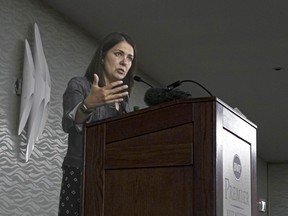
Article content
UCP leadership candidate Danielle Smith’s dabbles in quackery are sometimes almost funny. This one is dangerous.
Her bizarre statement about cancer care could encourage patients not to seek “mainstream” or “traditional” care until their cancer is at stage four. By which time, in many cases, the patients will die no matter what care they get.
If I’d followed her prescription, I might very well be dead, too. We’ll get to that.
Smith talked to a naturopath for an hour on a campaign video. The shared assumption was that mainstream medicine does little to foster wellness or prevent illness. For that, it seems, we must turn to alternate, non-traditional medicine.
False. AHS has many prevention and wellness programs. Physicians’ primary care networks routinely refer patients to nutritionists, mental health consultants and other specialties. Health care usually pays for initial appointments.
I have nothing whatever against naturopaths. They are an accepted, regulated profession in Alberta.
But Smith’s casual acceptance of counter-mainstream claims is downright creepy. This mind in the premier’s office, having its way with modern medicine, could wreak havoc.
Smith said: “Once you’ve arrived and got stage 4 cancer, and there’s radiation and surgery and chemotherapy, those are incredibly expensive interventions, not just for the system, but also expensive in the toll it takes on the body.
“I think about everything that built up before you got to stage 4 and that diagnosis, that’s completely within your control, and there’s something that you can do about that that is different.”
She later fudged this but did not back away from her statement.
The response on Twitter and other social media was incandescent.
“Yeah, I encourage @ABDanielleSmith to visit a pediatric oncology ward and explain to those kids what they should have done differently,” Steve Lillebuen said
Smith’s opponent Brian Jean responded: “When it comes to cancer you don’t know what you are talking about.
“Having lost a child and other family members to cancer I think I can speak on behalf of many parents and loved ones.
“You saying to someone that their cancer is ‘completely within your control’ before stage four is insensitive, hurtful and outright untrue.
“Please stop.”
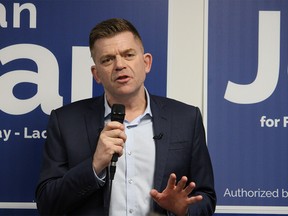
When I was diagnosed with prostate cancer about eight years ago, I immediately got excellent advice about how to take care of myself, what to eat and not eat, how much to drink, how to lose weight. All of it came from “mainstream” experts.
Older men with low-grade prostate cancer are often called “watch and wait” cases. The reason is not flattering. “At your age you’ll probably die with the cancer rather than of it,” one doctor said.
Nonetheless, my doctors watched me like hawks over a gopher.
I had regular tests, constant wellness reminders. I quit drinking and eventually lost nearly 60 pounds.
The cancer paid no attention. Over a few months two years ago, my PSA reading — the key metric for tracking prostate cancer — vaulted from seven to 17. An urgent biopsy showed a dangerously aggressive cell at work.
At this point I was at stage two, far short of stage four. The cancer was still contained. I was given hormone therapy, which checks the cancer’s growth while giving you the dawning sensibility of a woman (and I mean that seriously.)
Then began a month of radiation therapy — 20 blasts on a Tom Baker table from super-skilled docs and technicians. This is a demanding regime and it does come with awkward after-effects.
But three months after it ended, my PSA level had plunged to 0.3. There it has stayed for more than a year. I was declared cancer free.
My point is: I did everything I was advised to do, including wellness and prevention help, and the cancer still broke loose. It was not in my control no matter how hard I tried to run it off.
I am well today precisely because I got regular “mainstream” assessments at every step, and therapy started at the first sign of serious danger.
Please, do not take your medical advice from Danielle Smith. The candidate is prone to quackery.
Don Braid’s column appears regularly in the Herald.
Twitter: @DonBraid
Tyson Fedor
CTV News Calgary Video Journalist
Follow | Contact
Updated July 26, 2022
Danielle Smith, the former Wildrose party leader and UCP leader hopeful is under fire after she hosted a podcast over the weekend with naturopathic doctor Dr. Christine Perkins talking about healthcare and the need for both mainstream and naturopathic medicines.
Smith and Perkins began talking about cancer patients, specifically those with stage four of the disease.
While listening to Perkins, Smith said she believes some of the blame falls at the hands of the patient.
“Once you’ve arrived and got stage four cancer and there’s radiation and surgery and chemotherapy, that is incredibly expensive intervention — not just for the system, but also expensive in the toll it takes on the body,” said Smith.
“But, when you think everything that built up before you got to stage four and that diagnosis, that’s completely within your control and there’s something you can do about that that is different.”
The pair talked about prevention with naturopathic medicines, before using mainstream medicine, such as chemotherapy and radiation, which they compared with being a ‘heroic’ medicine.
On Monday, Smith doubled down, saying the NDP attacked her for her comments.
“She (Dr. Perkins) is quite correct, the first three stages of cancer are more controllable in what complete care is available to a patient but once you get to stage four, that's when the patient is less in control,” said Smith in a Twitter video.
“Apparently everyone knows it to be true, except apparently for the NDP who want to use it as a wedge issue to attack me. I think that's beneath even them, and Albertans are tired of this.”
Smith responding to several politicians who have blasted her for spreading misinformation, including NDP leader Rachel Notley.
But she is also facing blowback from fellow UCP leadership contenders, with almost all coming out and criticizing her viewpoints.
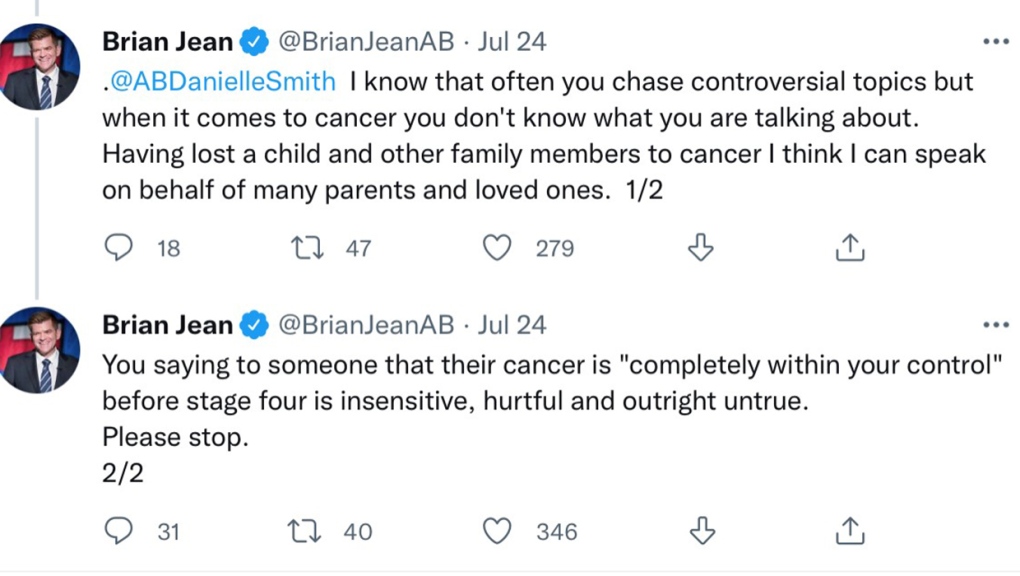
Leadership hopeful Travis Toews said he was surprised by the comments.
“Cancer is such an emotional issue, there have been so many families that have been touched by that disease, I don’t want to further politicize it,” said Toews.

For Rebecca Schulz, who is also seeking the leadership she believes these statements are what leads to a divided province.
“Saying things like this that are untrue, absolutely going to lead us to an NDP government on a silver platter,” she said.
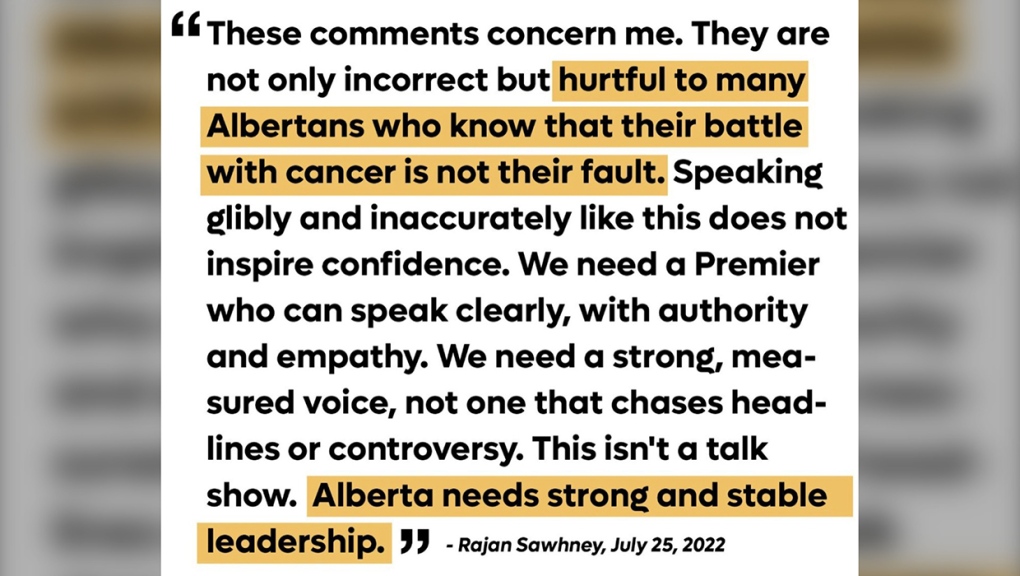
Timothy Caulfield, an expert in health law and policy at the University of Alberta, said these comments frustrate healthcare professionals.
“There is no evidence to support her claims,” he said.
“In fact the evidence tells us that alternative medicine, there have been a number of large studies on this, alternative medicine is associated with worse outcomes.”
He suggested that it's Smith who is politicizing cancer.
“You would think that a politician would be more sensitive more careful about spreading misinformation, health misinformation like this. We don’t need to legitimize pseudoscience, we need more good science,” said Caulfield.
He added that he does agree that lifestyle choices such as exercise, not smoking and eating well are alternative medicines in themselves to hopefully prevent deadly diseases.
Smith’s campaign did not make her available for an interview on Tuesday, referring CTV back to her podcast and video statement.

UCP leadership candidate Danielle Smith is under fire for remarks she made about people with cancer








/cdn.vox-cdn.com/uploads/chorus_image/image/71171645/1236627019.0.jpg)
